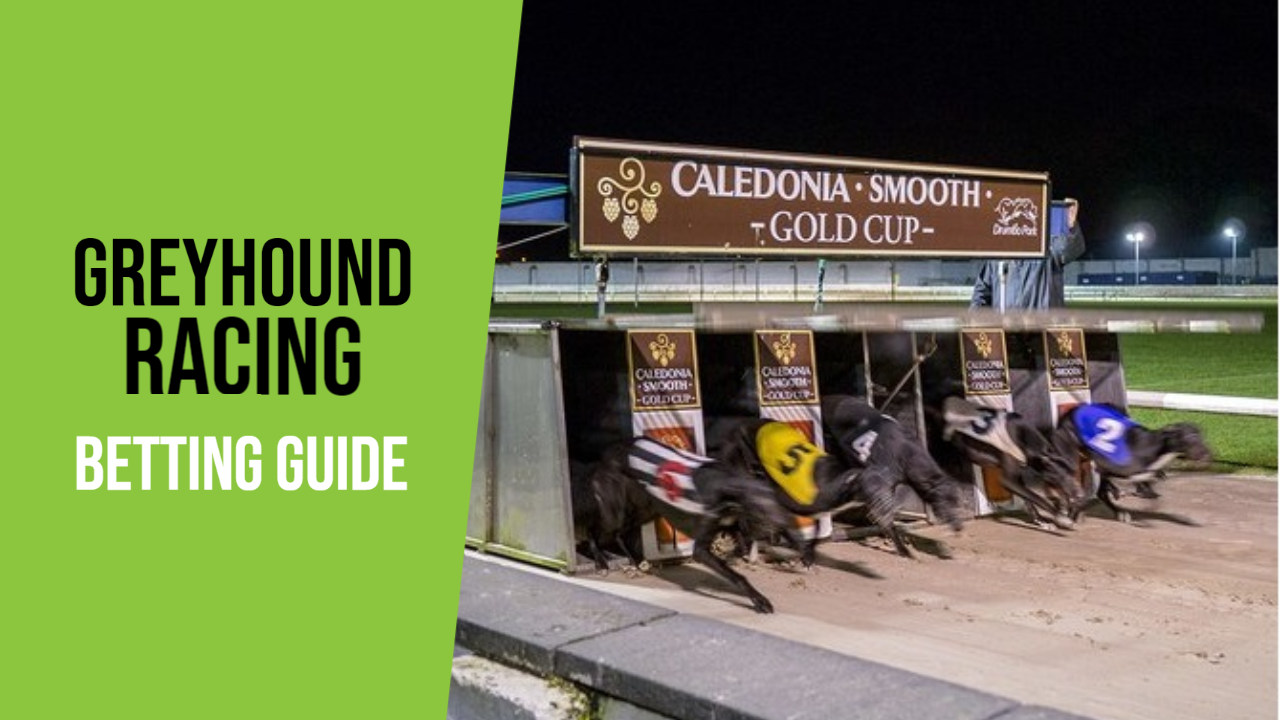
This greyhound racing guide provides a clear overview of the sport and the key factors that influence race outcomes. You’ll also find trusted websites for placing greyhound bets and accessing useful data. Whether you’re new to the sport or looking to improve your edge, this guide will help you make smarter betting decisions.
About Greyhound Betting
Greyhound racing is a high-speed sport where six to eight dogs compete around an oval track, chasing a mechanical lure. Races are short and explosive — usually lasting under 30 seconds — and are held regularly at tracks across the UK, Ireland, Australia, and parts of the US.
Many bookmakers now also offer virtual greyhound racing, which simulates real races using RNG (random number generator) software. These events run around the clock and follow the same structure and betting markets as live races — but without real dogs, trainers, or form to analyse.
While greyhound racing remains a popular betting sport, it has also faced criticism over animal welfare concerns. As a result, the industry is more tightly regulated in some regions, and the sport has been banned outright in others. Still, it continues to attract dedicated followers and frequent punters — particularly where data and trackside performance can be reliably assessed.
Why Bet On Greyhound Racing?
-
Fast-Paced Action
With races lasting under 30 seconds, there’s minimal downtime — ideal for bettors who enjoy quick results.
-
Strategic Analysis
Serious bettors can study form guides, split times, trap bias, and recent performance to inform their selections.
-
Social Experience
Whether at the track or online, greyhound betting can be a shared experience among friends or fellow punters.
-
Community Appeal
Some fans enjoy following specific kennels, trainers, or dogs — fostering a loyal and engaged betting community.
Popular Greyhound Competitions
Major greyhound racing events are held throughout the year in the UK, Ireland, Australia, and beyond. These races attract the top dogs, trainers, and bettors — often featuring large prize pools and strong betting interest. Some of the most prestigious competitions include:
- English Greyhound Derby (UK): The most prestigious greyhound race in Britain, held annually at Towcester over 500m, with a six-figure winner’s purse and extensive betting markets.
- Irish Greyhound Derby (Ireland): Hosted at Shelbourne Park in Dublin, this event is one of the biggest in Europe, offering high prize money and attracting strong local and international betting activity.
- Melbourne Cup (Australia): The richest greyhound race in the world, held at Sandown Park. It features the best sprinters in Australia and commands major attention from punters.
- Golden Easter Egg (Australia): A flagship race at Wentworth Park in Sydney, known for its fast times, elite fields, and strong betting turnover.
- Sandown Cup (Australia): The top long-distance greyhound event in Australia, offering big prize money and a tactical betting angle for stayers.
- Dundalk International (Ireland): An invitation-only race featuring top-class runners, held at Dundalk Stadium. It’s a key highlight on the Irish greyhound calendar.
- Northern Flat (UK): One of the longest-running Category 1 events in the UK, now hosted at Newcastle. A key race for middle-distance specialists.
Best Bookmakers for Greyhound Betting
I recommend the following bookmakers for placing greyhound racing bets:
#ad ● 18+ ● Play Safe ● GambleAware.org
#ad ● 18+ ● Play Safe ● GambleAware.org
#ad ● 18+ ● Play Safe ● GambleAware.org
#ad ● 18+ ● Play Safe ● GambleAware.org
#ad ● 18+ ● Play Safe ● GambleAware.org
#ad ● 18+ ● Play Safe ● GambleAware.org
New UK customers. Min £10 first deposit. Place a bet of £10 at min odds of 2.0 and get £40 in Free Bets within 48 hours. Restrictions apply. Full T&Cs apply, 18+. BeGambleAware.org
#ad ● 18+ ● Play Safe ● GambleAware.org
#ad ● 18+ ● Play Safe ● GambleAware.org
#ad ● 18+ ● Play Safe ● GambleAware.org
#ad ● 18+ ● Play Safe ● GambleAware.org
Considerations for Greyhound Betting
Greyhound racing can be considered a simple sport in terms of its basic rules and objective: greyhounds chase a mechanical lure around a track to see which one can finish first.
However, there are many factors that can influence the outcome of a greyhound race, such as the conditions of the track, the form of the individual dogs, and the tactics employed by the trainers.
Current Form
A greyhound’s recent performance is one of the clearest indicators of how it might run. Look for dogs showing consistency in times, placing regularly, or improving with each outing. Avoid those coming off a series of poor runs — especially if they’ve shown signs of fatigue or injury.
- Age affects stamina and speed — younger dogs may lack experience, while older dogs may be past their peak.
- Injuries or recent layoffs can cause dips in performance.
- Race fitness improves with regular competition; overly rested dogs may not start sharply.
- Temperament also matters — dogs that break cleanly and handle pressure tend to deliver more reliable performances.
Track Conditions
Track layout and surface conditions can heavily influence race outcomes. No two tracks are identical, and some dogs favour certain venues more than others.
- Surface (e.g. sand) may run slower or faster depending on moisture and weather.
- Track length can favour early speed or staying power, depending on the dog’s racing style.
- Bend configuration affects how tightly dogs must turn — a key variable for those with wide or rail preferences.
- Weather (like rain) can alter the surface and slow down certain lanes.
- Track bias occasionally favours certain traps or lanes — especially in wet or heavily used conditions.
Smart bettors keep track of how dogs perform under different surface and weather combinations.
Box Draw
The trap number (or box draw) determines a dog’s starting position and can significantly affect the outcome.
- Inside traps (e.g. 1 & 2) offer the shortest line to the rail but may be more congested.
- Middle traps give a balanced start and can benefit well-rounded dogs with no strong lane bias.
- Outside traps (e.g. 7 & 8) are often seen as disadvantageous — unless the dog has early pace and prefers a wide line.
Always compare the box draw with the dog’s preferred running style. A rail runner starting from a wide trap is often a red flag.
Running Style & Tactics
Every dog has a natural racing style — and understanding it helps explain how a race might unfold.
- Early speed dogs often win by leading into the first bend and avoiding traffic.
- Railers hug the inside line for efficiency, but can be vulnerable if boxed in.
- Wide runners prefer space and may struggle if trapped between dogs early.
- Strong finishers are dangerous late in the race, especially over longer distances.
A well-timed break, clean run, and ability to avoid traffic are often more important than raw speed.
Trainers & Kennels
The influence of a trainer or kennel should not be overlooked. Top handlers tend to have better-conditioned dogs, superior tactics, and deeper understanding of when and where to race.
- Winning strike rate is often a good indicator of quality and consistency.
- Track records can highlight which trainers dominate at certain venues.
- Kennel form (overall recent performance) may signal that multiple dogs are running well under the same handler.
Following in-form kennels can reveal value in races where the market hasn’t fully caught on.
Genetics & Breeding
While less relevant for casual bettors, a dog’s pedigree can offer long-term clues — particularly in top-tier races.
- Offspring from successful sire lines often show natural speed, stamina, or race awareness.
- Conformation (body shape, stride, strength) impacts how efficiently a dog moves.
- Temperament traits, like aggression out of the traps or racing focus, can also be inherited.
Pedigree matters most in high-stakes events or when evaluating young, unexposed runners.
Greyhound Betting Markets
Greyhound betting offers a range of markets — from simple win bets to more complex combinations. Understanding how each market works will help you find the best value based on your betting style.
- Win – Bet on a single greyhound to win the race.
- Each-Way – A split bet: half goes on the win, half on the greyhound to place (typically top 2 or 3, depending on the field).
- Forecast & Tricast Bets – Predict the top finishers in the correct or any order:
- Straight Forecast – Pick the first and second dogs in the exact order (also called an Exacta).
- Reversed Forecast – Pick two dogs to finish first and second in any order (also known as a Quinella).
- Combination Forecast – Select 3+ dogs; win if any two finish first and second in any order.
- Straight Tricast – Predict the first, second, and third dogs in the exact order.
- Combination Tricast – Pick 3+ dogs to finish in the top three in any order.
- Accumulator – Combine multiple win bets into one. All selections must win for the bet to land.
- Tote – A pool-based system where all bets are combined, and the winnings are split among those who bet on the correct outcome. Tote odds can differ from fixed odds.
Different markets suit different approaches. Straight win bets offer clarity, while forecasts and tricasts provide bigger payouts but require more accuracy. Compare market types and odds to find what works best for your strategy.
Best Sites for Greyhound Stats
Access to up-to-date stats is key to making smarter greyhound bets. These websites offer free data on form, times, trap history, and more:
You can learn more about these sites here: Best Sites For Free Greyhound Racing Statistics
Greyhound Racing FAQ
Greyhound racing is a sport where six to eight greyhounds chase a mechanical lure around an oval track. The first dog to cross the finish line wins. Races are short, fast-paced, and typically completed in under 30 seconds. Betting is a major part of the sport, with punters placing wagers on outcomes such as the race winner, forecasts, or tricast combinations.
Races are scored simply: the order in which the dogs finish determines the result. There’s no points system used for betting purposes. However, points may be awarded in tournament formats or league systems to determine progression or overall standings.
The lure is an artificial object (usually made of synthetic fur or plastic) attached to a motorised rail system that runs ahead of the dogs during the race. It mimics prey, encouraging the greyhounds to chase it instinctively around the track. The lure is always kept ahead of the dogs to maintain motivation and ensure fair racing.
A trap is the numbered starting box from which each greyhound begins the race. Traps are typically assigned randomly, and the draw can impact performance depending on a dog’s running style. For example, rail-running dogs may perform better from inside traps (1 or 2), while wide runners may prefer outside positions.
Trap bias varies by track and surface conditions. On many UK tracks, inside traps (especially trap 1) tend to have a higher win percentage due to the shorter route to the rail. However, if a dog prefers to run wide, it may be hindered by an inside position. Always check a dog’s previous performance by trap number and running style before betting.
In a handicap race, dogs are given staggered starting positions based on ability. Faster dogs may start further back to level the playing field. This format is less common than standard races but offers different betting dynamics — and occasionally higher odds for favourites.
Greyhound racing is regulated and licensed in countries where it remains legal, and most races are fair. However, as with any betting sport, there’s always a small risk of malpractice.
Stick to reputable bookmakers and focus on tracks with strong oversight and transparency to reduce risk. If odds shift sharply before a race, it may indicate inside information — but it doesn’t always mean foul play.
- SBK Review | The Bookie With Outstanding Odds [2025] - December 6, 2025
- Sportmarket Review|Leading Odds & High Limits From One Account [2025] - December 6, 2025
- Should You Take Early Prices For Your Betting Strategy? - December 6, 2025










